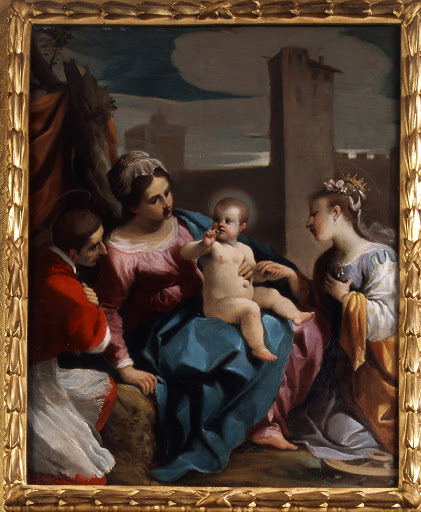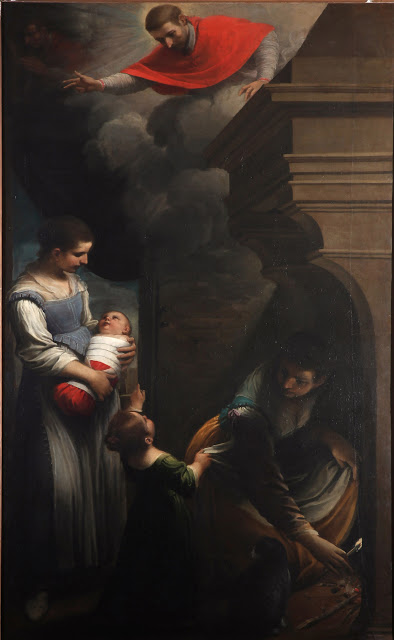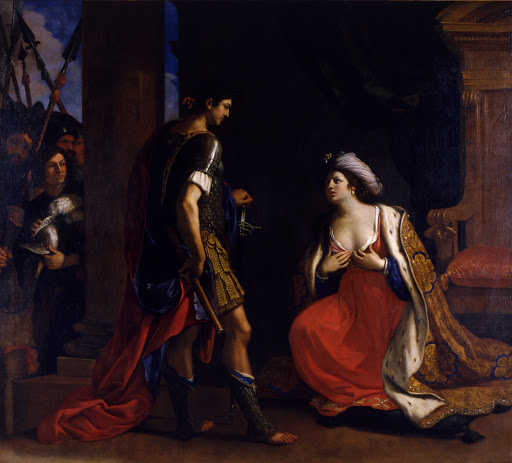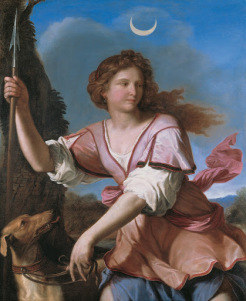Guercino Exhibit at Palazzo Barberini
As a baby in his cradle he was noticed to be cross-eyed, and so Giovanni Francesco Barbieri became know as il Guercino, "the squinter", a nickname that stuck until his death. Luckily, this supposed cross-eyedness did not affect his painting skills. Born in 1591 in Cento, a small town in Emilia-Romagna, Guercino's talent was recognized early, and he was sent to study in Bologna, before eventually migrating south to Rome, once again the center of the art world and the heart of the Baroque explosion.
But Guercino never quite fit in with his fellow artists. His work was too sensitive and full of emotion to be considered classical, yet too colorful and romantic to be considered naturalistic. He struck the perfect happy medium between Carracci and Caravaggio, although in his early period he occasionally showed signs of being influenced by the great Caravaggio, particularly in the painting above. Does it remind you just a bit of Caravaggio's Madonna di Loreto? Yeah, me too. But the work above was painted a full two years before Guercino came to Rome, so the similarity is most likely purely coincidence.
It was his brilliant chromatic ability that set Guercino apart from the others. Photographs can never capture the true colors of a painting, particularly if they are appearing on a computer screen, so I urge you to visit the exhibit in person if you are in Rome. His use of lapis lazuli outdoes even Michelangelo.
Today a new exhibition of 36 of this incredible artist's paintings opens in Palazzo Barberini's new exhibition space. This massive area on the ground floor of the exquisite baroque palace is over 1000 square meters, and this is only the second exhibit to be housed there, in what is expected to be a long series of mostre, each one focusing on a different painter. (Rumor has it Antoniazzo Romano is next, an artist who has the distinction of being the first Roman Renaissance painter!) What is fascinating about this exhibit is that it gives you a thorough understanding of the entire career of the great Emilian master, with a large selection of his early works, all on loan from his home town of Cento, a second section devoted to the work he executed in Rome, while working for the Emilian pope, Gregory XV Ludovisi, and a third section with his later works, created after his return to Emilia-Romagna. The three areas are clearly distinct from one another by the bright colors of the walls: cobalt, crimson and lilac, respectively.
In the stunning painting above, one of my favorites of the mostra, St. Carlo Borromeo performs a miracle, giving sight to a blind infant. The women, taken with the quotidian worries of life, are not able to perceive what is happening. But the little girl sees a vision of the saint, and tries to get her mother's attention by pulling on her apron. Even the cat is aware of something out of the ordinary.
The painting above, long believed to depict Augustus, has recently been considered by some to depict Julius Caesar instead. What do you think? I personally think the original idea is right. The soldier here looks quite young, and Caesar was considerably older than Cleopatra. And she doesn't seem to be in her first flush of youth, but instead older than the man in front of her. But I could be wrong!
Only in Guercino's later work, from the 1640s onward, does he fully embrace classicism, becoming more inspired by Guido Reni than any other artist. How different, for example, is the Sibyl below from the one above? So much more intellectual and cold, almost as if she is posing for the artist, as opposed to the plumper, more life-like version above. At least his northern talent for color never changed.
She looks like she could be the long-lost sister of Reni's Beatrice Cenci!
You're probably thinking right now, "Tiffany, how do you know so much about Guercino?" Okay, maybe not, but I can dream, can't I? Well, immediately following the press conference yesterday, just as I was beginning to admire the works, I had the fortune of bumping into Fausto Gozzi, one of the curators of the exhibit and the one of the world's leading Guercino experts. He led a few of us through the exhibit, explaining several of the works in detail, and giving us a greater understanding of the distinct phases of Guercino's long career
All images provided courtesy of Ufficio Stampa Civita









